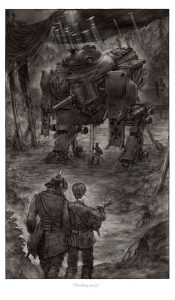
Example of Clanker technology from the 1914-ish world of “Leviathan.”
According to Wikipedia, the term was probably coined by science-fiction writer K. W. Jeter as a humorous variation of cyberpunk—which itself is a type of science fiction described as “high tech/low life.”
Steampunk is a blend of sci-fi/alternative-history/speculative fiction with a historical setting (Victorian Britain is typical, though later Edwardian and turn-of-the-century settings may appear) but nonhistorical features, such as flying machines, robots, heavy metal and alternative physics. Darwinism often makes up part of the philosophical framework, and science cult figures like Nicolai Tesla or Isaac Newton may show up in the cast of characters. Because of the emphasis on technology it’s more science fiction than fantasy, and could be seen as an update on Jules Verne and H. G. Wells. Steampunk can be dark, but not so much in its juvenile manifestations; it’s mostly an opportunity for the old-fashioned adventure yarn. I’m personally drawn to the historical settings, and a steam aficionado besides (my husband once worked on a steam-operated railroad). In our solid-state, micro-transistor age, the combination of water and heat, clank and hiss and moving parts, has a certain romance about it. (My favorite scene in the movie Titanic is that of the engine room!)
One advantage of middle-grade and YA steampunk is its appeal for boys. It’s almost always written by men and shows an exceptional fascination with machines and inventions, characterized by swift action and desperate situations and exploration into the way things work in this imaginary world. Girls (speaking for myself) can appreciate this, if it doesn’t go too much into detail. Some great recent examples of steampunk for younger readers are the Airborn trilogy, the Larklight trilogy, and the Leviathan trilogy.
Support our writers and help keep Redeemed Reader ad-free by joining the Redeemed Reader Fellowship.
Stay Up to Date!
Get the information you need to make wise choices about books for your children and teens.
Our weekly newsletter includes our latest reviews, related links from around the web, a featured book list, book trivia, and more. We never sell your information. You may unsubscribe at any time.
We'd love to hear from you!
Our comments are now limited to our members (both Silver and Golden Key). Members, you just need to log in with your normal log-in credentials!
Not a member yet? You can join the Silver Key ($2.99/month) for a free 2-week trial. Cancel at any time. Find out more about membership here.
3 Comments
Leave a Comment
You must be logged in to post a comment.


Fascinating. Glad to be more informed about about a genre of fiction I’d never heard of!
I haven’t read much sci-fi, but as the girls get older, I think I’ll try to catch up a little. My brother really enjoys a series by Orson Scott Card, and I’ve been promising to read it for sometime. I think he is intrigued by the convergence of story and technology and politics…but I’ll have to read it before I could say more!
I’m more than a bit disturbed by the “Darwinism often makes up part of the philosophical framework” aspect of these books, with no apparent countering with anything resembling the truth of scripture, or even a mention of God. I’m wondering why this “fun…steampunk” is considered okay by ‘redeemed readers’ for their impressionable children?
Judilyn, I’m glad you brought this up. It’s probably an issue that will occur from time to time on this blog, and please understand that I know you’re the best judge of what your children should read. Let me say this for this sake of discussion, though:
I know young people who were raised in Christian schools, possibly even homeschooled for a few years, whose faith was destroyed after a few years in college. The reasons for this are complex, but a contributing factor, I think, is that we teach our kids what to think , but not always how to think, especially about ungodly beliefs. They’re not taught to intellectually engage some of the ideas that weave their way into the very fabric of the culture, or even to recognize them.
I see that as one purpose literature can serve: an opportunity to grapple with underlying assumptions in a safe environment before you have to go out and confront them in the world. A 13-year-old boy whose parents have taught him the case against Darwinism is not likely to be converted to an evolutionary worldview by reading Airborn (or, for a better example, Leviathan), but some healthy parent/child discussion about such books can help him see what the effects of Darwinism are and how to think about them. I tried to give parents an idea of how to do this with Leviathan–which is far more explicit than Airborn is. Again, it’s entirely up to the parent, but I hope that helps explain where I’m coming from.